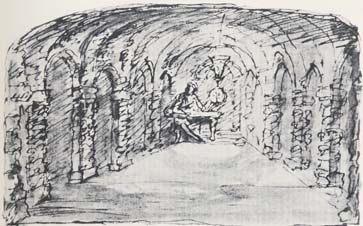 The literary Grub
Street production “strikingly invokes the cultural dynamics of the carnivalesque:
its irreverence, its suspension of hierarchical distinctions, its preoccupation
with the body, and its invigorating energy all capture the carnivalesque
impulse.”11
These are the characteristic features of the Grub Street production Pope is so afraid of. Among these features the poet seems to be obsessed
with the image of the body. This obsession, or more precisely fear, does not
only regard the body that may symbolize female literary production in general.
It is more complex and also regards Pope's body. This essay, in
order to prove that Pope participates in the feminization of literature, will
concentrate on the grotesque primarily seen as an expression of fear in the
beholder.
The literary Grub
Street production “strikingly invokes the cultural dynamics of the carnivalesque:
its irreverence, its suspension of hierarchical distinctions, its preoccupation
with the body, and its invigorating energy all capture the carnivalesque
impulse.”11
These are the characteristic features of the Grub Street production Pope is so afraid of. Among these features the poet seems to be obsessed
with the image of the body. This obsession, or more precisely fear, does not
only regard the body that may symbolize female literary production in general.
It is more complex and also regards Pope's body. This essay, in
order to prove that Pope participates in the feminization of literature, will
concentrate on the grotesque primarily seen as an expression of fear in the
beholder.
12
In general in the eighteenth century the concept of “grotesque” is
understood as the distortion of the natural order of the surrounding world. It
interprets exaggeration and excess as a drive toward “the breaking up of the
established world order. . . .”13
Many writers utilize grotesque motifs to express a sense of absurdity in the
world. In this grotesque world the boundaries between animals, plants and humans
are blurred, order and proportion being subverted. Thus, the grotesque remains
in opposition to the natural and the classical. The excerpt from the Tatler
reading: “Sir, . . . . you have employed yourself more in grotesque figures
than in beauties, . . .”14
suggests that in the eighteenth century the grotesque and beautiful are
antipodean styles. However, following Ingrassia’s argument, it appears that
the contrasting styles come together. Therefore, Pope’s employment of the
grotesque not only ridicules the world he describes but also links him to the
world. This essay will further argue that it is the grotesque that puts the
unstable boundaries of gender under pressure, making the poet an influential
figure in the process of literary feminization.













The literary Grub
Street production “strikingly invokes the cultural dynamics of the carnivalesque:
its irreverence, its suspension of hierarchical distinctions, its preoccupation
with the body, and its invigorating energy all capture the carnivalesque
impulse.”11
These are the characteristic features of the Grub Street production Pope is so afraid of. Among these features the poet seems to be obsessed
with the image of the body. This obsession, or more precisely fear, does not
only regard the body that may symbolize female literary production in general.
It is more complex and also regards Pope's body. This essay, in
order to prove that Pope participates in the feminization of literature, will
concentrate on the grotesque primarily seen as an expression of fear in the
beholder.